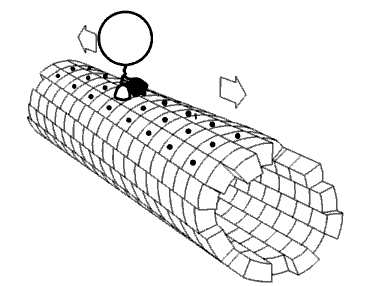
Photo from academic.microsoft.com
We discuss recent observations of polymorphic chromatin packaging at the oligo-nucleosomal level and compare them with computer simulations. Our computations reveal two topologically different families of two-start 30-nm fiber conformations… Click to show full abstract
We discuss recent observations of polymorphic chromatin packaging at the oligo-nucleosomal level and compare them with computer simulations. Our computations reveal two topologically different families of two-start 30-nm fiber conformations distinguished by the linker length, L: fibers with L ≈ 10n and L ≈ 10n+5 bp have DNA linking numbers per nucleosome of ΔLk ≈ -1.5 and -1.0, respectively (where n is a natural number). While fibers with ΔLk ≈ -1.5 were observed earlier, the topoisomer with ΔLk ≈ -1.0 is novel. These predictions were confirmed experimentally for circular nucleosome arrays with precisely positioned nucleosomes. We suggest that topological polymorphism of chromatin may play a role in transcription, with the {10n+5} fibers producing transcriptionally competent chromatin structures. This hypothesis is consistent with available data for yeast and partially, for fly. We show that both fiber topoisomers (with ΔLk ≈ -1.5 and -1.0) have to be taken into account to interpret experimental data obtained using new techniques: genome-wide Micro-C, Hi-CO and RICC-seq, as well as self-association of nucleosome arrays in vitro. The relative stability of these topoisomers is likely to depend on epigenetic histone modifications modulating the strength of inter-nucleosome interactions. Potentially, our findings may reflect a general tendency of functionally distinct parts of the genome to retain topologically different higher-order structures.
Journal Title: Biophysical journal
Year Published: 2021
Link to full text (if available)
Share on Social Media: Sign Up to like & get
recommendations!